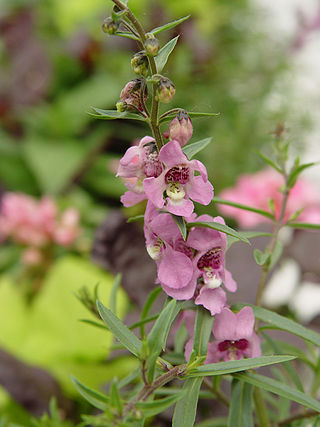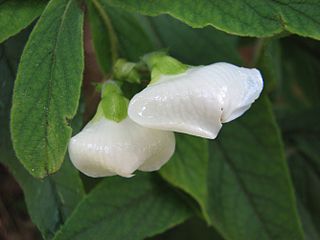
Indigofera is a large genus of over 750 species of flowering plants belonging to the pea family Fabaceae. They are widely distributed throughout the tropical and subtropical regions of the world.

Plectranthus is a genus of about 85 species of flowering plants from the sage family, Lamiaceae, found mostly in southern and tropical Africa and Madagascar. Common names include spur-flower. Plectranthus species are herbaceous perennial plants, rarely annuals or soft-wooded shrubs, sometimes succulent; sometimes with a tuberous base.

Angelonia is a genus of about 30 species which occur from Mexico to Argentina and is classified in the Plantaginaceae. They are herbaceous plants occurring mainly in arid and semi-arid habitats. Most Angelonia species can be found in Northeastern Brazil in the Seasonally Dry Tropical Forest namely Caatinga. The flowers of Angelonia are highly specialized for pollination because they have hairs in the inner corolla, which produces oils collected by oil bee pollinators, especially of the genus Centris.

Lagochilus is a genus of the mint family that contains Turkistan mint.

Lotononis is a genus of flowering plants in the family Fabaceae and the tribe Crotalarieae. The genus includes 99 species of annual and perennial herbs, native to the southeastern Europe and Turkey, eastern Africa, and southern Africa.

Diascia is a genus of around 70 species of herbaceous annual and perennial flowering plants of the family Scrophulariaceae, native to southern Africa, including South Africa, Lesotho and neighbouring areas.

Aspalathus is a genus of flowering plants in the family Fabaceae. The yellow flowers and spiny habit of some species have suggested a resemblance to Ulex europaeus, the thorny "English gorse" Accordingly, "Cape Gorse" has been proposed as a common name although the resemblance is largely superficial; for instance, gorse is thorny, whereas Aspalathus species are variously spiny or unarmed. The genus belongs to the subfamily Faboideae. There are over 270 species, mainly endemic to southwestern fynbos regions in South Africa, with over fifty occurring on the Cape Peninsula alone. The species Aspalathus linearis is commercially important, being farmed as the source of Rooibos tea.

Stilbaceae is a family of flowering plants in the order Lamiales.

Acmispon is a genus of flowering plant in the family Fabaceae (legumes), native to North America and the west coast of Chile in South America. It includes several species of American bird's-foot trefoils and deervetches formerly contained in the globally distributed genus Lotus. The former genus Syrmatium is included in Acmispon. The Jepson eFlora accepts only Acmispon.

Anastrabe is a genus of flowering plants in the family Stilbaceae described as a genus in 1836.

Cycnium is a genus of flowering plants in the family Orobanchaceae. Its native range is tropical and southern Africa and Madagascar.

Colpias is a monotypic genus of flowering plant in the family Scrophulariaceae. It has only one currently accepted species, Colpias mollis, native to South Africa. It secretes oils to attract specialised oil-collecting bees from the genus Rediviva. It is also known by the name klipblom, meaning stone plant in Afrikaans.

Anticharis is a genus of flowering plants belonging to the family Scrophulariaceae.
Aptosimum is a genus of flowering plants belonging to the family Scrophulariaceae.

Manulea is a genus of flowering plants belonging to the family Scrophulariaceae.

Plicosepalus is a genus of hemiparasitic flowering plants belonging to the family Loranthaceae.















